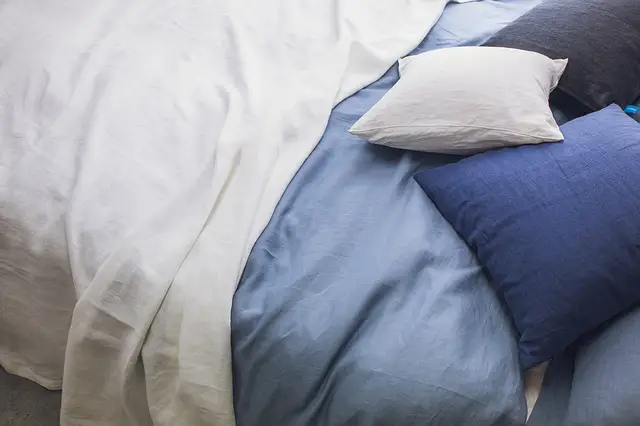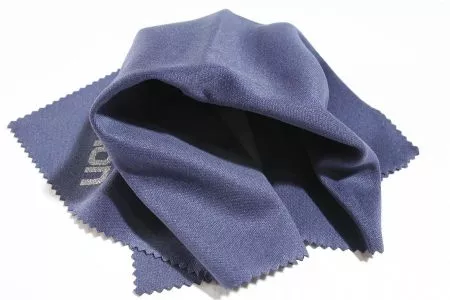If you look at the clothes in your closet, you will find different garments made from various fabrics. Some of the common fabrics in the cabinet are linen, cotton, spandex, rayon, polyester, and nylon. To take good care of your garments and maintain them well, you need to know whether the fabrics make your clothes shrink or stretch. It is thus likely you might find yourself asking, does linen shrink?
Indeed, linen as a natural fiber shrinks when subjected to hot temperatures. Typically, linen shrinks when washed in warm and hot water or dried in the dryer at temperatures above 1040F or 400 C). When linen fibers contact warm or hot water, they relax and then return to their initial size, shrinking the fabric. As a result, linen fabric can stretch anything between 3% and 4%.
This article discusses linen fabric in great detail as it concentrates on shrinking the fabric. The article explains whether the fabric shrinks or stretches, how it shrinks, how to shrink linen garments, whether linen shrinks more than cotton, and whether linen blends shrink. Just read the entire article and understand the linen fabric better.
What Is Linen?
Linen is a hard-wearing fiber that is obtained from the flax plant. Even though linen is to a great extent identical to cotton, it is made from flax’s stem, while cotton is made from the bolls that are found in the cottonseed.
Compared to cotton, the manufacturing of linen demands more time and resources. As a result, linen has, over the years, been more expensive than cotton.
Specifically, linen is hard to weave when weaving as its fiber is easily broken in the production process, meaning more care needs to be taken during the production process. Due to that, linen clothes are always expensive.
The linen fabric is made from 7 different Steps, as detailed below.
Step 1: Planting – Flax plants which linen is derived from are planted and mature, ready for harvest in 100 days.
Step 2: Garnering – When the flax plant grows, it is harvested. In modern times, flax is harvested by machines.
Step 3: Breaking – The harvested flax stocks are broken up so that the outer fibers that cannot be used are separated from the inside parts used.
Step 4: Combing – The inner fibers are readied for spinning by combing them into thin strands.
Step 5: Spinning – The strands combed in the previous step are linked with spreaders and spined.
Step 6: Reeling – The yarn is reeled into a bobbin after spinning.
Step 7: Drying – The yarn in the bobbin can then be dyed, treated, and used to make different products.
The five main producers of linen in the world comprise of United States, China, Belgium, Ireland, and Italy.
Pros of Linen
It is environmentally friendly as it is made from flax that does not pollute the environment for it to grow.
It is very strong and actually the strongest natural fiber (10 times stronger than cotton).
It is highly breathable and absorbent.
Has properties that repel insects.
Is easy to maintain.
Inhibits bacteria.
Its anti-static.
Cons of Linen
Creases easily.
Expensive while compared to other fabrics.
Linen garments feel rough when wore for the first time.
Difficult to iron.
Susceptible to mildew and perspiration.
Challenging to remove creases.
To ensure that linen strengths are exploited while the weaknesses are fixed, linen fiber is generally blended with other fibers with values that will complement known weaknesses of the linen fiber.
For example, when linen is blended with soft rayon, the linen rayon blend produces a soft fabric and has a more fluid drape, while other strengths of linen still prevail in the blend.
When blended with cotton, the linen/cotton blend produces a soft fabric, is less likely to get wrinkles, and has a crisp appearance, while all other strengths of linen are also evident in the blend.
Does Linen Shrink?
Yes, linen shrinks.
Linen fabric shrinks mainly due to the relaxation of the linen fibers. Tension is created during the reeling and weaving processes since linen fibers are pulled, strained, twisted, and straightened. When put in water, linen fibers relax. Moreover, the heat and friction inside the washing machine and the dryer decrease the tension in the linen fibers. When linen fibers relax and return to their natural position, a shrink is created.
To prevent linen from shrinking or minimize linen shrinkage, linen can be washed in cold water and air-dried. The high temperatures and agitation in the washing machine and dryer that causes shrinking will be avoided.
When using a washing machine and a dryer, low heat settings on the washing machine and dryer will help minimize shrinking. Moreover, a gentle cycle should be used at all times. For example, if you want to iron your linen garment, always set the iron to the lowest temperature.
Why Does Linen Shrink?
The main reason why linen shrink is due to the linen fiber structure made from the flax plant. Specifically, when linen fabric comes into contact with water and any heat, linen fibers tend to relax. This relaxation makes fibers go back to their original size. As a result, linen shrinks.
If you take two linen fabrics and put one in hot or warm water and the other one in cold water, then take the two fabrics out of the water after 60 minutes, the fabric in warm or hot water will have a considerable shrinkage while the one in cold water will have minimal shrinkage.
To minimize the chances of your linen fabric shrinking, always clean your linen with lukewarm water, don’t use a dryer, air-dry the linen fabric, and never use bleach on the linen fabric.
How Much Does Linen Shrink?
When you wash linen for the first time, the fabric will naturally shrink. In most cases, linen shrinks up to 4%.
I carried out a test on a linen queen-size fitted sheet while strictly adhering to the washing and drying guidelines indicated on the care label. Below are the findings.
| Width | Length | Depths | % Change | |
| Size Before Washing | 63’’ | 84’’ | 18.50’’ | 0 |
| Size After First Wash | 61’’ | 82.10’’ | 18.00’’ | 0 |
| Size After Second Wash | 60.8’’ | 81.10’’ | 17.75’’ | 3.7 |
| Size After Third Wash | 60.01’’ | 80.60’’ | 17.50’’ | 4.20 |
| Size After Fourth Wash | 60.00’’ | 80.50’’ | 17.5’’ | 5.40 |
As is evident from the above table, the manufacturer of the linen bedsheet had taken into consideration the shrinking percentage and made sure that the sheet would perfectly cover a queen-sized mattress even when washed many times.
The other notable finding was that, in this case, the linen bed sheet shrank an average of 3.33% during the four washes. This is a good indicator that linen fabric can shrink anything by 3 – 4 %.
However, it is essential to note that if linen was to be washed in hot water and dried in higher temperature settings, the percentage of linen shrinkage would be higher and can even shrink up to 10%, especially when not pre-washed.
Does Linen Shrink In The Dryer?
Linen shrinks in the dryer since once the linen fabric is put in the dryer, the heat inside the dryer makes the linen fibers reduce their tension, thus resulting in shrinkage. In addition, tossing the linen fabric inside the dryer also contributes to the linen fabric shrinking.
Depending on the settings of your dryer, linen can shrink up to 10% if your drier heat is set at the highest point. Linen in the dryer can shrink anything between 3% to 5 % for a medium heat setting. However, if you have a linen blend, that will also significantly impact the shrinkage of your linen fabric.
How To Shrink Linen
To successfully shrink your linen garment, you must understand that shrinkage will occur when both heat and moisture trigger the linen fibers and make them vulnerable to alterations in shape as the fabric is agitated through washing or in the dryer.
Since linen is a natural fiber made from the flax plant, linen fibers are known to absorb water readily. Thus, linen is likely to shrink when it comes into contact with water or heat. If you want to deliberately make your linen dress, shirt, or garment smaller, you can wash it on a long cycle in warm water. You can then dry the garment on a hot cycle.
When in the dryer, you must regularly check the garment to avoid over-shrinking. When you have the shrinking size you want, you should take the garment out of the dryer and air dry it.
Does Linen Shrink Or Stretch
Linen shrinks and does not stretch. Linen is one of the few fibers that have relaxation shrinkage value. Due to the relaxation shrinkage value, when linen fabric comes into contact with water, the fabrics relax, resulting in shrinkage. Nevertheless, subjecting linen fabric to heat results in higher shrinkage.
Because of stretching, 100% linen fabric cannot stretch. Linen has a low elasticity value, and for that reason, it will never stretch on its own. However, when linen is blended with high elasticity fabrics, the linen blend can stretch.
Does Linen Shrink After Washing?
As linen fiber has relaxation shrinkage, linen will shrink when washed. Specifically, when linen comes into contact with water, its fibers relax, and as they return to their original position, linen shrinks.
If you don’t want your linen to shrink a lot, always make sure to shrink the linen fabric in lukewarm water. In addition, you need to make sure that linen fabric does not stay long in the washing machine. To dry linen and shrink it, use a delicate dry cycle. Please note that the longer linen stays in the dryer, the more it will shrink.
Does 100% Linen Shrink?
Yes, 100% linen shrink. As linen is a natural fiber, and these fibers are known to shrink, 100% linen shrinks when it comes into contact with moisture and heat. Thus, when linen is put in warm water, the fabric shrinks.
If you don’t want your linen fabric to shrink, you should wash the fabric in lukewarm water and use gentle wash and dry cycles. To avoid shrinking during drying, linen should be dried on a flat surface.
Does Linen Shrink More Than Cotton?
The extent to which a fabric shrinks is determined by the fibers making up the fabric.
Linen and cotton are both natural fibers derived from plants. However, despite linen being stronger than cotton, linen tends to shrink more than cotton. The high shrinkage in linen is caused by the linen fiber obtained from the flax plant. When this fiber comes into contact with water, it relaxes more, unlike the case with cotton fibers. This high relaxation in linen is what makes linen shrink more than cotton.
Does Linen Shrink When Dry Cleaned?
When dry cleaned, linen will shrink. The shrink in dry cleaning will be caused by heat inside the dry-cleaning machine and the moisture that comes from the cleaning solvent and steam present in the dry cleaning process.
Therefore, if you want to ensure that your linen garment does not shrink, you should consider washing it in lukewarm water instead of dry cleaning it. When you put your linen fabric in the dry cleaner, you need to use a cleaning solvent.
Even if there is no water involved in the dry-cleaning process, the solvent creates steam when ‘heated’ inside the dry-cleaning machine. It is this steam that ends up shrinking your linen fabrics.
When the flax fibers making up the linen fabric contact this steam in the dry-cleaning machine, the fibers relax. As a result, the linen fabric shrinks as the fibers return to their original position.
To prevent linen clothes from shrinking, cloth manufacturers always ensure they pre-wash most linen clothes. However, as the linen clothes get dirty and are washed a couple of times, the pre-wash value of the linen clothes declines, making them susceptible to shrinkage.
To delay the shrinking of your beloved linen clothes, always wash linen clothes only when necessary to wash them.
Does Linen Blend Shrink?
A linen blend is made up of two fibers that complement each other. In that view, even if linen is known to have high shrinking values, a linen blend might not shrink in case the additional fiber in the blend is shrink resistant and, in the blend, it has the highest percentage.
To determine whether a linen blend will shrink, you will need to find out the percentages of the fibers in the linen blend and the shrinking values of these fibers.
Let’s now look at different linen blends and whether they shrink.
Does Rayon and Linen Shrink?
Rayon is a semi-synthetic fiber, while linen is a natural fiber. These two fibers are known to have high shrinkage values. Thus, the rayon and linen blend will shrink.
The rayon and linen blend can be shrunk by; washing in hot water and drying in hot temperatures, putting the garment in hot water, and using a hot iron. The rayon and linen blend can shrink up to 10% in hot temperatures.
Does Viscose Linen Shrink?
Viscose is a semi-synthetic fiber that is shrinkable. On the other hand, Linen is a natural fiber that has a high shrinking value. The viscose linen blend is thus shrinkable.
Due to the shrinking aspect of both fibers of viscose and linen, the percentage of viscose fiber and the percentage of linen fiber will not be of significant concern. However, the fact that the two fibers in the blend can shrink implies that the viscose linen blend will shrink up to 10%.
Does Cotton Linen Blend Stretch?
Cotton and linen-blend do not stretch. Both cotton and linen fibers lack the natural stretch that other fabrics have. However, that does not imply that cotton and linen blends cannot stretch. Both cotton and linen stretch over time, and the blend can also be woven differently or manipulated deliberately to make the blend stretchable.
Thus, if you want to make sure that your fabric made of cotton and linen can stretch, you should refer to the care label since even though natural cotton and linen cannot stretch, the fabric might have been modified to stretch.
How to Unshrink Linen?
If your linen garments have shrunk, and you are considering throwing the garments away, don’t do it yet. You have a chance of unshrinking the linen garment and probably getting it close to its original size.
However, take note the extent to which you will succeed in unshrinking your garment will be determined by the extent of the shrinkage. If the garment has shrunk a lot, you might not get it anywhere back to its initial size.
To unshrink linen, you will need
A washing basis
A flat surface or clothesline
Iron
Craft table or ironing board
Process of unshrinking linen
Step 1: Fill the washbasin with lukewarm water – between 80 – 90 degrees Fahrenheit.
Step 2: Immerse the linen fabric in the lukewarm water – make sure the material is fully immersed.
Step 3: Leave the linen fabric fully immersed in the lukewarm water for 10 minutes.
Step 4: Gently squeeze water from the linen fabric.
Step 5: Dry the damp linen fabric on a flat surface or a clothesline.
Step 6: After the linen fabric is dry, put it on the craft table or ironing board.
Step 7: Turn on the iron and set the heat to a warm setting.
Step 8: Gradually iron the fabric from one edge to the other.
Step 9: Once you have finished ironing, check your fabric size to find whether you have the desired size. If not, repeat the unshrink process.
Concluding Thoughts
Linen clothes are classy and expensive. The last thing you expect from your fabric is for it to shrink. This article has looked into how linen shrinks and how you can unshrink the garment if it shrinks too much. Just take good care of your linen clothes, and you will have the clothes with you for a long time.







